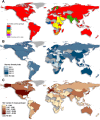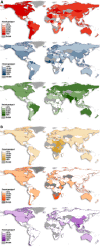Global distribution and prevalence of hepatitis C virus genotypes
- PMID: 25069599
- PMCID: PMC4303918
- DOI: 10.1002/hep.27259
Global distribution and prevalence of hepatitis C virus genotypes
Abstract
Hepatitis C virus (HCV) exhibits high genetic diversity, characterized by regional variations in genotype prevalence. This poses a challenge to the improved development of vaccines and pan-genotypic treatments, which require the consideration of global trends in HCV genotype prevalence. Here we provide the first comprehensive survey of these trends. To approximate national HCV genotype prevalence, studies published between 1989 and 2013 reporting HCV genotypes are reviewed and combined with overall HCV prevalence estimates from the Global Burden of Disease (GBD) project. We also generate regional and global genotype prevalence estimates, inferring data for countries lacking genotype information. We include 1,217 studies in our analysis, representing 117 countries and 90% of the global population. We calculate that HCV genotype 1 is the most prevalent worldwide, comprising 83.4 million cases (46.2% of all HCV cases), approximately one-third of which are in East Asia. Genotype 3 is the next most prevalent globally (54.3 million, 30.1%); genotypes 2, 4, and 6 are responsible for a total 22.8% of all cases; genotype 5 comprises the remaining <1%. While genotypes 1 and 3 dominate in most countries irrespective of economic status, the largest proportions of genotypes 4 and 5 are in lower-income countries.
Conclusion: Although genotype 1 is most common worldwide, nongenotype 1 HCV cases—which are less well served by advances in vaccine and drug development—still comprise over half of all HCV cases. Relative genotype proportions are needed to inform healthcare models, which must be geographically tailored to specific countries or regions in order to improve access to new treatments. Genotype surveillance data are needed from many countries to improve estimates of unmet need.
© 2014 The Authors. Hepatology published by Wiley on behalf of the American Association for the Study of Liver Diseases.
Figures



References
-
- Cooke GS, Lemoine M, Thursz M, Gore C, Swan T, Kamarulzaman A, et al. Viral hepatitis and the Global Burden of Disease: a need to regroup. J Viral Hepat. 2013;20:600–601. - PubMed
-
- Mohd Hanafiah K, Groeger J, Flaxman AD, Wiersma ST. Global epidemiology of hepatitis C virus infection: new estimates of age-specific antibody to HCV seroprevalence. Hepatology. 2013;57:1333–1342. - PubMed
-
- Lauer GM, Walker BD. Hepatitis C virus infection. N Engl J Med. 2001;345:41–52. - PubMed
Publication types
MeSH terms
Grants and funding
LinkOut - more resources
Full Text Sources
Other Literature Sources
Medical
